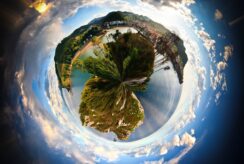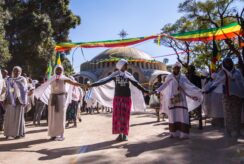Landed in Reykjavik, my friend Simon was arriving next day, what let me some time to explore the city. I didn’t know that a Penis Museum existed, went for a hike on the jetty, visit city center and gathered informations for the round trip. On the way back to the guesthouse, I passed by Hallgrimskirkja Church. A massive waved-designed tower, a bit 8-bit minecraft style.
Next morning, we took our rent Kia Picanto and started the journey on the road, on the menus, rocks, waterfalls, fjords, glaciers …
Two weapons, the forecast app and a website that monitors the magnetic index. Strategy is to avoid heavy rains for day time, and get nice foreground clear sky at night to chase northern lights. The weather seems to be better north … Let’s do our loop clockwise.
Heading North, first target was on the western peninsula of Iceland, the ‘church rock’ and its waterfalls, Kirkjufell.
Five hours drive later, we parked the car at destination. All we could see was … heavy rain.
And this for 3 hours long. The waterfalls were supposed just 500m in front of us but as we could see just 30m … Whole day and whole night in a dense cold fog, bad luck. Let’s try elsewhere. 0 photo taken so far.
The road is empty, just some snow plows, local pickups, we get quite skeptical about our small car and its tired snow tires …
Colors are gone, just white, grey, black. From time to time, a bit of green field, riddled by massive dark volcanic rocks. The wind is blowing quite hard, but the cloud seem stationary, just getting denser.
Even the sea is just a calm grey mirror.
Finally rain stopped and we made it to the Dino Rock. Quiet tied made this dino look even more peaceful. This 50m rock layer is Hvítserkur Sea Stack, also called the Troll of North-West Iceland. Hvítserkur would mean ‘white long shirt’ due to guano cover.
Legends suppose it to be a petrified troll. As non-christian, he didn’t like the sound of the church’s bell that came from the local convent. He decided, on a night, to go and tear it down, but couldn’t make it back home before the first lights of the sun … and ended petrified there, maybe having to hear the new bell for a long time …

You can find so many waterfalls in Iceland all having their particularity. Some are powerful, with high flow, some are tall, some are thin, and some are known for their geological singularity.
One of them in particular, is Aldeyjarfoss. Known as the ‘the perfect photographer location in Iceland’, this waterfall is the original inspiration for the church in Reykjavík.
The other singularity was for us that the way to get there in winter is supposed to be tricky, icy and hard. With our car even more … Never try, never know …
Straight on the way was Sellfoss, perfect to spend a sunrise. The flow is large, high and strong, covering our voices, and the camera click.
The sunrise colors finally integrate the dark grey sky. Three hours inside this loud silence, adjusting composition, and getting hypnotized by the flow.
Back in the car to Aldeyjarfoss, weather was ok. We parked close to a farmer’s house, couldn’t go much further. We could barely notice to path, as the snow covered it all. But we believed we have the good directions. I wish I had my crampons.
Two hours later, 20 falls on ice under thin layer of snow, could see the waterfall appearing behind the crest. Not that tall, 20m high, the flow is quick and generous. We now can hear it.
This waters are flowing there from the biggest glacier of Europe, Vatnajokull.
Almost all the base of the waterfall is made of basalt organ pipes. The principle of this phenomena is almost the same as geometric mud cracks on an dried rain puddle. The erupted lava took this shape, cooling quickly to the contact of water of air, getting contracted and fractured.
As we woke up close to Godafoss the next morning, and it snew all night, we just went back to yesterday’s waterfalls too see what they look like with an extra layer of snow. Worth it. And fortunately for the second one, we already knew the way ! Otherwise it was almost impossible.
Hike time was multiplied by 2, number of falls by 3 … And maybe we lost couple of hours, getting helped by locals, to get the car out of snow and ice…
We were their first today …
To thank them, and I was even more surprised as they were receiving it, I gave them a Camembert I brought from France. Stinkiest gift ever.
We just could spend 20mn at the waterfall this day, no need to add the night as extra danger.

All along our way, there were so many waterfalls.
Dettifoss, the Europe most powerful. Seljalandsfoss and Svartifoss, where you can walk behind. Skogafoss, just side of the road … Gljufrafoss, almost hidden behind a thin layer of rock. And numerous others close to the main road …

After being definitely sure that it’s not safe to drive this car there, we made it to the south east main road. We literally slept on black ice and luckily stopped safe after an unwanted u-turn.
Landscape is has a bit more relief here. Active volcanoes, massive glacier tongues, mountains diving in the sea in majestic fjords, black sand beaches…
One of the most intense sunrise of my life, in Stokksness. Black sand peninsula, yellow rushes patches, low tide with big wave, water trapped on the beach so it makes a perfect mirror, sea birds passing by, summits sprinkled by snow, so many details … Looked like a painting.

Jokulsarlon lake is the deepest in Iceland. Massive iceberg stands int it and sometimes you can see or hear a sea lion popping and breathing, struggling etc get on a ice patch and get a rest.
Big ice blocks get pushed to the sea, floats in the tide and the waves and most of the time get pushed back on the black sand. This makes an incredible contrast, and is a perfect place for long exposure.
The magnetic index was 6/10, sky was supposed to be clear. Really worth it to stay there for sunset and more.
This northern light was wide and intense. The camera could get the color of the sky, but our eyes could just see some minty-grey weird-shaped clouds dancing, hiding and revealing stars. Cold to the bones, in the wind, but so stunned.

Back at the guesthouse, when the owner sees us that frozen, he showed us a big wooden box at the back of the garden, and said it was ready.
Five minutes later, an open air hot-spring, with edges full of snow. 40° inside, -4° outside.
You can smell the sulfur and volcanic aspect of the water. In Iceland, the mainly use geothermal energy, approximatively half of their total energy consumption. It provides hot water for locals, is transformed in power stations, and can have clever usage such as warming pavement in the cities during winter.
We ended this trip in the Golden Triangle, the most famous part of Iceland where almost all the tourists spend their few days. Here is the popular blue lagoon, some geysers and waterfalls.

As a bit too crowded, we decided to give a last chance to Kirkjufell, instead of staying in the triangle. We arrived at night, and the sky was active.
When I finally saw the church rock, once again I could understand the shape of Reikjavik’s church.
The loop ended there, with northern lights, waterfalls, giving a mystical dimension to this last night.



